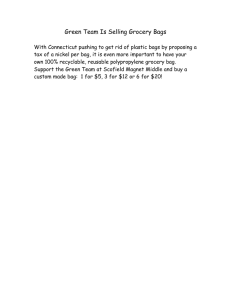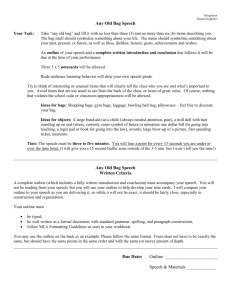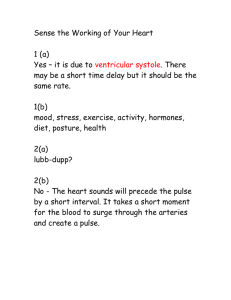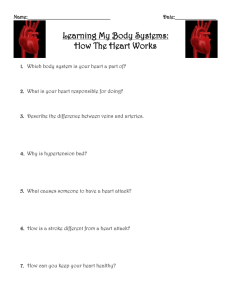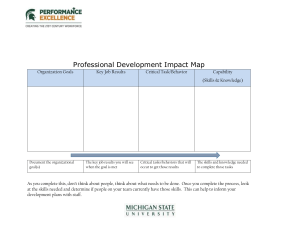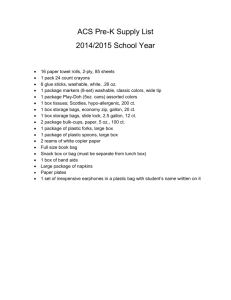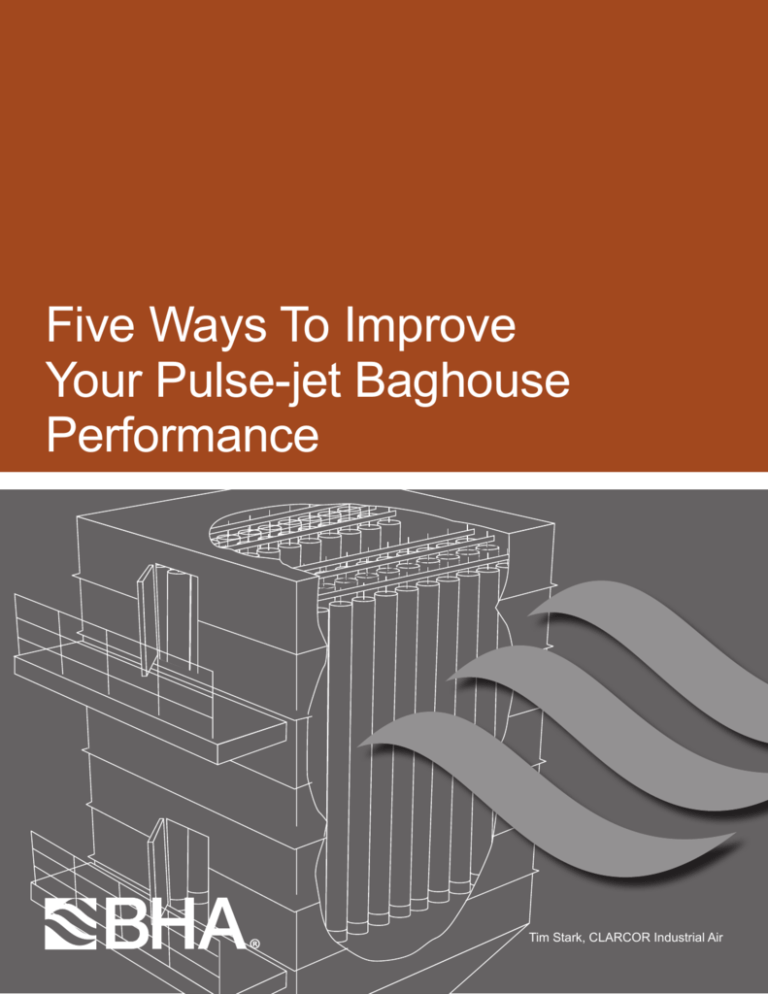
Five Ways To Improve
Your Pulse-jet Baghouse
Performance
Tim Stark, CLARCOR Industrial Air
An inefficient pulse-jet baghouse dust collector can lead to unnecessary
downtime, excess energy consumption, and ineffective dust filtration. However,
you can implement cost-effective modifications and upgrades that will provide an
immediate impact on overall baghouse performance without having to completely
rebuild your dust collector.
1
Correctly install the
bag filters.
Ensure that your baghouse
dust collector’s bag filters are
correctly installed; this will
maximize the filter media’s
operating life and minimize downtime and
maintenance costs. Check that bag filters
with flanges or cuffs that fold over the
tops of their support cages are smooth
around the edge to prevent leakage and
bag abrasion. Install bottom loading bags
so that their seams are 180 degrees
from the split or gap in the cage collar;
facing all bags the same direction will aid
troubleshooting procedures. Install the bag
clamps 90 degrees from the bag seam and
position them on the groove in the cage
to ensure a tight seal. Install top-loading
snapband bags with their seams all facing
the same direction to allow you to quickly
and easily identify areas where prob- lems
may occur.
The clean-on-demand system takes
the guesswork out of knowing when to
manually activate and deactivate the
baghouse pulse cleaning cycle.
2
Use a clean-on-demand
system.
A typical automatic clean-ondemand system for a pulse-jet
baghouse dust collector consists
of a differential pressure gauge
and a programmable controller. The
differential pressure gauge measures
the difference in pressure between the
dirty-air side and clean-air side of the bag
filters in the baghouse. The pressure gauge
sends the differential pressure readings to
the controller, which is programmed with
a high and low pressure set point. When
the differential pressure reaches the high
pressure setpoint, the controller activates
the baghouse’s pulse cleaning cycle, which
restructures the dustcake on the filters while
moving a portion of the dust into the hopper
of the baghouse, lowering the pressure.
When the differential pressure reaches the
low pressure set point, the controller shuts
down the pulse-cleaning cycle.
2
Installing a clean-on-demand system
in your baghouse is fairly easy and
inexpensive to do, especially when
compared to the benefits you’ll receive
from using one. The clean-on-demand
system takes the guesswork out of
knowing when to manually activate and
deactivate the baghouse pulse cleaning
cycle and helps prevent the bag filters
from being over or under cleaned. Properly
cleaning the bag filters optimizes their
dust collection efficiency and maximizes
their operating life, which reduces the
baghouse’s energy and compressed air
requirements and helps minimize your
operating and maintenance costs.
3
Integrate other controllers
with a clean-on-demand
system.
When a bag filter is pulsed,
the air pulse removes the
collected dust from the bag
and rearranges the remaining dustcake
structure on the bag’s surface. If the bag
filter rows in a baghouse with high upward
gas velocities are pulsed sequentially,
one row after the other, submicron dust
from the bags being cleaned can migrate
back onto the clean bags in the previous
row. When this occurs, a dense dust cake
can form on the bags, which leads to
higher differential pressures and inefficient
baghouse operation. You can avoid this
by using a sequential controller to stagger
the pulse cleaning system’s bag row
activation order.
each subsequent row is pulsed
only when the compressed air pressure
in the system’s header is fully regained.
This will produce a consistent pulse force
for each bag filter row and ensure that
the bags are properly cleaned. To further
ensure proper bag cleaning, make sure
that the pulse generated during the pulsecleaning cycle is short and crisp, generally
about a 0.1-second interval.
If your baghouse doesn’t have a differential
pressure clean-on-demand system,
you can use a controller that can be
programmed to activate the pulse-cleaning
system based on time. A potentiometer
on the control panel allows you to activate
the pulse cleaning cycle from every 3 to
30 seconds or more, depending on your
process operating parameters. Since it’s
vital to maintain a proper dustcake layer
on the bag filters, the cleaning frequency
should be set to ensure that the bags are
not over- or under-cleaned.
To centralize control of your baghouse dust
collector, you can install an LED controller
that provides a 4- to 20-milliamp signal to
an external PLC controller or computer
for remote monitoring and control. This
will also allow you to collect and store
differential pressure readings, pulse
cleaning cycle activation and deactivation
times, and other operating parameters.
Such operational records will help you
more quickly pinpoint problem areas and
correct them.
A sequential controller controls the order
in which the bag filter rows are cleaned
when the pulse-cleaning cycle is activated.
Staggering the order of rows to be cleaned
lessens dust re-entrainment on the
bags and improves dustcake formation
for optimum filtration effectiveness. For
example, you can program the sequential
controller to pulse-clean rows 1, 4, 7, 10,
2, 5, 8, 3, 6, 9, and so on until all of the
bags have been cleaned.
When using a sequential controller,
program the pulse frequency rate so that
This cutaway image shows the correct
installation of an automatic clean-on-demand
system’s differential pressure gauge.
4
Install 1.5-inch double diaphragm pulse valves in the
pulse-jet cleaning system.
In a pulse-jet baghouse dust collector, the diaphragm pulse
valves that generate the pulse air for cleaning the bag
filters must be able to create a crisp and instantaneous air
pulse that travels the entire length of each bag like a shock
wave to effectively clean it. A 1.5-inch double diaphragm pulse valve
easily accomplishes this and is much more effective than a smaller
size double diaphragm valve or any single diaphragm valve.
When a double diaphragm valve operates, it releases through a small
vent port in the pilot solenoid valve a comparatively small volume
of air that’s holding a small secondary diaphragm closed. At the
same time, the air pressure holding the main diaphragm closed is
released through a large vent port in the pulse valve, which allows
an immediate discharge of pulse air into the blowpipe to generate
a strong air pulse in the bags. In contrast, a single diaphragm valve
releases all of the air that holds the diaphragm closed, and that air
then travels the length of the pilot tubing and escapes through a small
vent port in the pilot solenoid valve. This slows the release of pulse
air into the blowpipe and lim- its the air pulse in the bags.
In addition to releasing the pulse air more quickly and forcefully, a 1.5
inch double diaphragm valve and blowpipe have a 1.76 square inch
cross-sectional area, which provides sufficient area for the pulse air
to flow unimpeded to all blowpipe orifices. In contrast, a 1 inch double
diaphragm pulse valve and blowpipe have a 0.88 square inch crosssectional area, which imposes a restricted area that impedes the
airflow to the blowpipe orifices.
Changing to a 1.5-inch double diaphragm valve is fairly easy to
accomplish and should save you a significant amount of money in
bag change outs and production loss caused by insufficient bag
cleaning.
5
Use a leak detection powder.
Many plants spend time manually inspecting each bag filter
for tears, holes, and leaking seams, which can take many
hours and often doesn’t find all leaks. In addition, structural
air leaks in the baghouse, such as from weld cracks or
misfitted metal enclosure covers, can’t be detected unless
they’re clearly visible. A more accurate way to test for such leaks is
by using a leak detection powder, also called a tracer powder.
A leak detection powder is an inexpensive, lightweight
fluorescent powder that you inject into the baghouse.
A leak detection powder is an inexpensive, lightweight fluorescent
pow- der that you inject into the baghouse. The powder will take the
path of least resistance and move with the air through any leaks,
accumulating around the openings. To make the powder fluoresce
(glow brightly), which pinpoints a leak’s location and severity, shine
a monochromatic light into the baghouse. After repairing the leaks,
conduct a second test with a different color powder to ensure that
you’ve found and eliminated all leaks.
To ensure that you find all the leaks regardless of their size, use a
leak detection powder with varying particle sizes to minimize fabric
bleedthrough. Additionally, select the powder color best suited for
your application since some colors work better than others depending
on the application and dust being collected.
3
For more information, please contact your CLARCOR Industrial Air representative.
11501 Outlook Street, Suite 100 | Overland Park, KS 66211
T: +1.800.821.2222 | T: +1.816.356.8400 | F: +1.816.353.1873
Email: filtration@CLARCOR.com
www.bha.com
©2015 BHA Altair, LLC. All rights reserved. BHA is a registered trademark of BHA Altair, LLC.
BHA350 (04/2015)

